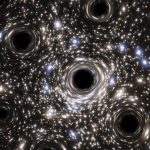Key Takeaways:
- Astronomers have discovered a unique six-planet system orbiting the star HD 158259, 88 light-years away, with almost perfect orbital resonance.
- The star is similar in mass to the Sun and is orbited by a super-Earth and five mini-Neptunes.
- Orbital resonance is a rare phenomenon where planets exert gravitational influence on each other, and in this system, each planet is in an almost 3:2 resonance with the next.
- The precise measurements of these orbits were made using the SOPHIE spectrograph and TESS exoplanet-hunting space telescope.
- The resonance suggests that the planets did not form in their current positions but likely migrated closer to the star.
- Understanding these resonances and differences in orbital periods can provide insights into planetary formation and evolution.
Astronomers have unveiled a remarkable celestial revelation – a six-planet system encircling the distant star HD 158259, located 88 light-years away from Earth. This celestial gem stands out not only for its exquisite rarity but also for the wealth of knowledge it promises to offer. In an extraordinary dance of gravitational harmony, this sun, slightly larger than our own, plays host to a super-Earth and five mini-Neptunes, all twirling in almost perfect orbital resonance.
What exactly is orbital resonance? It’s a captivating celestial phenomenon where the gravitational interactions between celestial bodies create a rhythmic synchronization. In our Solar System, Pluto and Neptune engage in a 2:3 orbital resonance. Think of it as two musical instruments playing together, but with different rhythms – two beats for one, three for the other. Such resonances are scarce among planetary bodies, even in exoplanetary systems. However, HD 158259 boasts an almost 3:2 resonance, a period ratio of 1.5, among each of its neighboring planets. This means for every three orbits, one planet completes, the next one finishes two.
The meticulous measurement of these orbits was made possible by the cutting-edge technology of the SOPHIE spectrograph and the TESS exoplanet-hunting space telescope. These measurements revealed tightly packed orbits, with periods ranging from 2.17 to 17.4 days. While not absolutely perfect resonance, the slight variations are sufficient to categorize HD 158259 as an exceptional system.
The intriguing part is that these findings strongly suggest that these planets didn’t form in their present locations. Rather, they likely migrated inward towards the star from a more distant origin. This migration could be attributed to the dynamics of a protoplanetary disc, where planetary embryos grow and move inward, generating a cascade of orbital resonances.
As the remaining gas in the disc dissipates, it could destabilize these orbital resonances, shedding light on the intricate mechanisms of planetary system formation. This revelation opens a window into understanding not only the formation of this extraordinary system but also the internal structures of its planets. The research, published in Astronomy & Astrophysics, marks a significant stride towards unraveling the mysteries of our universe’s intricate choreography.


